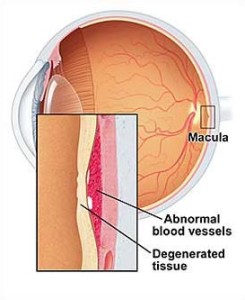 Age-related macular degeneration (AMD) is the leading cause of vision loss in the United States. Latin for spot, the macula is the region of greatest visual acuity near the center of the retina. The deterioration of this region is what constitutes AMD. Generally, patients do not go completely blind from AMD. Rather, they lose their central vision and the vision needed for reading or seeing fine details also becomes impaired. The disorder most commonly affects people over the age of 50. The risk of developing increases by approximately 35% after reaching 75 years of age.
Age-related macular degeneration (AMD) is the leading cause of vision loss in the United States. Latin for spot, the macula is the region of greatest visual acuity near the center of the retina. The deterioration of this region is what constitutes AMD. Generally, patients do not go completely blind from AMD. Rather, they lose their central vision and the vision needed for reading or seeing fine details also becomes impaired. The disorder most commonly affects people over the age of 50. The risk of developing increases by approximately 35% after reaching 75 years of age.
There are two types of Age-related Macular Degeneration:
- The most common form of AMD is dry AMD. Although dry AMD can lead to the more dangerous wet form of AMD, most patients with the dry form of AMD do not lose their central vision.
- Though developed by only 10% of AMD patients, the wet form of AMD makes up the greatest number of sufferers who endure serious vision loss from the condition.
The dry form of AMD is caused by the presence of yellow sediments, called drusen, in the macula. Drusen settles is allowed to settle there due to aging and thinning tissues in the macula. A small amount of drusen may not cause any change in vision at all. With time, however, the drusen may accumulate and increase in size causing some central vision loss for patients.
The wet form of Age-related Macular Degeneration occurs when there’s a growth of abnormal blood vessels beneath the macula. These blood vessels leak blood and fluid into the retina, eventually scarring, leading to permanent loss of central vision. Wet AMD is generally more aggressive causing faster and more visible vision loss.
In the early stages of AMD there may not be any symptoms at all. The condition may go completely unrecognized until it worsens or until both eyes are affected. The first indicator of Age-related Macular Degeneration is typically a dark or blurred spot in the center of a patient’s vision. Sufferers of AMD may also begin to see straight lines as wavy or distorted.
As with any condition, the earlier a person is aware of their condition the better off they are. So if at any time you experience these symptoms, contact your local Johnson Optometric Associates eye doctor immediately. AMD can be and is most commonly diagnosed by a comprehensive eye exam. So make sure to schedule your annual eye exam for you and yours today.
Johnson Optometric Associates
Serving Garner and Fuquay-Varina, North Carolina





2 thoughts on “A Comprehensive Look at Age-related Macular Degeneration”